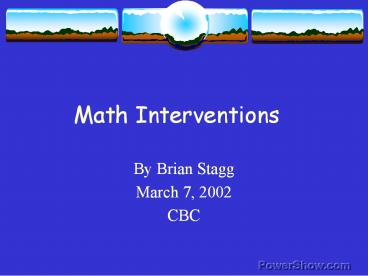Math Interventions - PowerPoint PPT Presentation
Title:
Math Interventions
Description:
Math Interventions – PowerPoint PPT presentation
Number of Views:747
Avg rating:3.0/5.0
Title: Math Interventions
1
Math Interventions
- By Brian Stagg
- March 7, 2002
- CBC
2
Background
- Current math curriculum is sequential
- Skills deficits become cumulative
- About 5 to 6 of students are Math LD
- 40 of 4th graders scored Below Basic Level
- Many students struggle with math especially
fluency
3
Common Skills Deficits
- Mastery of Computational Skills
- Rules
- Basic Operations
- Fluency
- Mathematic Applications
4
Common Errors
- 77
- 4
- 174
- 66
- -58
- 12
- 3
- 3
- 0
- 4
- -3
- 1
- 3
- 2
- 1
- 5
- -3
- 2
5
Errors cont.
- Carrying and Borrowing
- Computation and operations
- Both effect fluency and accuracy
6
Assessment
- Norm-referenced
- WIAT
- WJ-III
- Stanford Diagnostic Mathematic Test (SDTM)
- KeyMath-Revised
- Weaknesses
- General concepts broad-based
- Too few problems for proper assessment
7
Assessment CBM
- Assess a single skill
- Two-digit addition with borrowing
- Assess multiple skills
- Two-digit addition and subtraction
- Assesses fluency and accuracy
8
Other Assessments
- Error analysis looking at a common error over
many problems - CBM can be effective in determining EA
- Clinical Interviews
- CI entails asking the student to talk through the
steps he or she used to a solve a problem
9
Conducting CBM
- Use district scope and sequence list of
computational skills (appendix) - Construct 2 to 3 probe sheets with about 30 35
problems - Directions (see appendix)
10
Scoring
- Digits correct
- Add, Sub. Multiply is digits below the line
- 75
- x26
- 450
- 150_
- 2850
11
Scoring cont.
- 75
- x26
- 435
- 285_
- 3415
- Division GOOD LUCK (consult a book)
- Percent Correct divide of problems correct by
total of problems
12
Advantages of CBM
- Find systematic errors
- Specific skills deficits
- Chart progress
- Development of short and long term goals
13
Interventions
- Self-Monitoring
- Cover,Copy, and Compare
- Reciprocal Peer Tutoring (with parental
involvement) - Increasing Fluency with timing and reinforcement
14
Self-Monitoring
- Number of Problems completed and/or accuracy
- Student charts progress on a graph/chart (example
in appendix) - Cover, Copy and Compare
15
Cover Copy and Compare
- A sheet with about 10 problems w/answers in left
column and two other columns (copy and compare) - Student reads problem and answer
- Covers problem
- Then copies the problem and answer
- Uncover and compare answers
- Best for basic math facts
16
Reciprocal Peer Tutoring (RPT)
- Combines self-management techniques and group
contingencies within a peer tutoring format
(Rathvon, 1999 pp. 195). - Resources
- Paired-partners
- Flash cards w/problems and computational steps
- Problem drill sheets
- Reinforcement menu
- 30 minutes
- 4 section paper w/ Try 1 try 2 help and
try 3
17
RPT cont.
- Procedure
- Partners set a team goal and individual goal for
number of problems answered correct - One student act as teacher and gives flashcards
- The other answers the problems on 4-section paper
- Try 1 1st attempt
- Try 2 teacher prompt from card
- Help teacher models with instruction
- Try 3 retry
- Switch roles after 10 minutes
- After 2nd set each person completes a problem
drill sheet - If goals are met record on score card, and after
5 wins receive reinforcement item
18
RPT with Parental Involvement
- Same as RPT but with a parent component
- Procedure
- Inform parents of the program with a letter
(Rathvon, 1999. pp. 202-203) - Same procedure but after 3 wins send a parent
notification to reward the child - One variation is that the parents would return
the note indicating the reinforcement given - RPT allows you chart progress and evaluate
instruction
19
Other Interventions to Increase Fluency and
Accuracy
- Other types of progress charts and reinforcement
schedules - completed in time limit
- accurate in time limit
- Homework completion
- Reinforcement schedules at home or school
20
Alternative Interventions
- Cognitive Learning Strategies (Bruning, Schraw,
Ronning, 1999) - Focus on processes, structures and decisions, not
on answers - Problem-solving approaches
- Applications
21
Considerations for Interventions
- Do not be misguided or misdirected
- Prevent habituating incorrect routines
- Guarantee success (more correct answers)
- Offer alternative ways to display proficiency in
math - (Cawley Parmar, 1991)
22
Considerations for CBC
- Intervention at school and reinforcement at home
- CBM measures
- Assess
- Chart progress
- Data collection
- Parents practice and model homework with the
child - Peer tutoring
23
References
- Bruning, R. H., Schraw, G. J.,
Ronning, R. R. (1999). Cognitive Psychology and
Instruction. Upper Saddle River, NJ
Prentice-Hall. - Cawley, J. F., Parmar, R. S. (1991).
Maximizing mathematics success in the regular
classroom. In G. Stoner, M. R. Shinn, H. M.
Walker (Eds.), Interventions for achievement and
behavior problems. Silver Spring, MD NASP. - Fleischner, J. E., Manheimer, M. A.
(1997). Math interventions for students with
learning disabilities Myths and realities.
School Psychology Review, 26, 397-413. - Rathvon, N. (1999). Effective school
interventions Strategies for enhancing academic
achievement and social competence. New York
Guilford Press. - Shapiro, E. S. (1996). Academic skills
problems Direct assessment and intervention.
New York Guilford Press. - Shapiro, E. S., Kratochwill, T. R. (2000).
Conducting school-based assessments of child and
adolescent behavior. New York Guilford Press.































![[PDF] Essentials of Evidence-Based Academic Interventions 1st Edition Full PowerPoint PPT Presentation](https://s3.amazonaws.com/images.powershow.com/10077085.th0.jpg?_=20240711017)